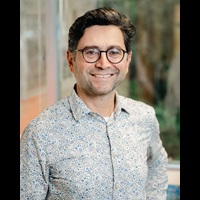 |
How Do You Feel? The Molecules That Sense Touch
Ardem Patapoutian, PhD
Scripps Research Institute/Howard Hughes Medical Institute
Saturday, November 12, 5:15–6:30 p.m. PST
Our sense of touch holds the capacity to connect us with the world and warn us of harm and hurt. These senses depend on mechanotransduction, the conversion of pressure into chemical signals. Dr. Patapoutian will discuss work from his laboratory that identified and characterized PIEZO1 and PIEZO2, pressure-activated cation channels. Genetic studies established that PIEZO2 is the principal mechanical transducer for touch, proprioception, baroreception, and bladder stretch, and that PIEZO1 mediates many mechanosensory roles throughout the body.
|
 |
The Basis of Sleep: What are We Learning From Small Animal Models
Amita Sehgal, PhD
Howard Hughes Medical Institute/Chronobiology and Sleep Institute/Perelman School of Medicine, University of Pennsylvania
Sunday, November 13, 5:15–6:30 p.m. PST
Studies of sleep have now expanded to diverse species, including invertebrates with very simple nervous systems. Mechanistic analyses in such models have identified molecules that regulate sleep as well as cellular functions served by sleep. Basic principles underlying sleep appear to be conserved across organisms, underscoring the relevance of an evolutionary approach. The lecture will focus largely on advances made in Drosophila and the extent to which these inform our understanding of sleep.
|
 |
The Neurobiology of Escaping From Predators
Tiago Branco, MD, PhD
UCL Sainsbury Wellcome Centre
Monday, November 14, 5:15–6:30 p.m. PST
Running away from threat is an ethological behavior that is universal across the animal kingdom. At one end, escape can be a simple reflexive action implemented across a few synaptic connections. At the other, evading predators might rely on coordinating sensory, motor and memory systems to rapidly navigate to a known safe place. This lecture will discuss the components of escape at the behavior level and highlight how cellular and neural circuit mechanisms work together to implement the underlying computations.
|
 |
The Macaque Face Patch System: A Turtle's Underbelly for the Brain
Doris Tsao, PhD
University of California, Berkeley/Howard Hughes Medical Institute
Tuesday, November 15, 5:15–6:30 p.m. PST
Research on the macaque face patch system has given us a remarkable window into the processes underlying visual object perception. This lecture will discuss the anatomy, coding principles, and behavioral role of this system. It will also tell how face patches, together with modern deep networks, reveal a unifying principle for inferotemporal organization in terms of ‘object space’. Finally, the lecture will discuss work exploiting feedback in this system to test if the brain encodes a generative model of reality.
|
























